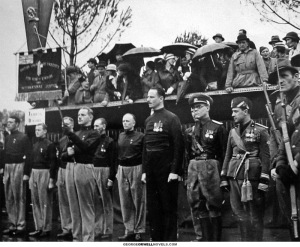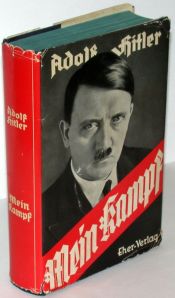
Tuesday 21 October 2014
In the final year of my History undergraduate degree I was fortunate enough to study fascism with Dr Maria Sophia Quine, one of the leading scholars in the field. The central point which I took away from the course was that fascism flourishes during a national crisis, more often than not this will be of the economic variety (e.g. mass unemployment). Since the interwar years, fascism has taken root as a protest vote against established political parties which are often closer to the liberal centre. In Weimar Germany, for example, the Nazi Party was able to gain so much support because of its promise to restore Germany back to its former, pre-First World War glory, not because of the antisemitic rhetoric that pervaded their manifesto, Hitler’s speeches and his book, Mein Kampf (although it would be wrong to say that these did not attract anybody at all). A similar thing had happened earlier in Italy, with Benito Mussolini’s PNF being the anti-communist bulwark desired by Italian elites. Legitimate ascensions to power by extreme parties occur in this way: disillusion with the establishment, and then protesting against it by voting for parties not considered to be a member of that set.
(As a side note, for a forceful overthrow of a government to happen then the group must have the backing of at least one of the armed forces and, probably nowadays, a subservient media. An example of this would be Francoist Spain emerging from the bloody Spanish Civil War, and the Generalissimo ruling until his death in 1975. This happens if the government in power either refuses to hold an election or the nation’s constitution stipulates that another election would not be for some time and, therefore, the extreme group believe that they have to act upon the groundswell of support which they currently have or risk losing it by the time of the next election.)
The continuing presence of fascist and neo-Nazi groups in the United Kingdom astounds me. I came to this topic in the same way that so many interesting tangents of tangents of tangents are stumbled upon: Wikipedia. I was researching UKIP for the article that I published in my previous entry (see Hiatus, UKIP, and Dan Carlin). From there I hunted for the British National Party to see what became of them, this led me to the National Front, which took me back to far-right groups from the 1960s, including the League of Empire Loyalists. The LEL brought me to the British Union of Fascists, which, in turn, took me to the Union Movement, at which point I noticed that it was only wound up in 1994, after it transformed into the Action Party in 1973. Moreover, the AP had a splinter group – the League of Saint George – which is still around today after splitting in 1974, likely as a result of the change from UM to AP. I wanted to find out about this group. Why would somebody persist in swearing their allegiance to a party, group or ideology which has little to no chance of attaining power by legitimate or, even, illegitimate means? The financial crisis of 2008 and the subsequent global depression was a huge worldwide problem; but the only gain of any real significance for the far-right was the 21 seats (recently down to 18) which were won in 2012 in the Hellenic Parliament by the Greek fascist party, Chrysí Avgí (Golden Dawn). In an effort to try to understand what makes the League tick, I went to their website – and it is extraordinary.

Their homepage describes them as dedicated ‘to [Oswald] Mosley’s concept of a united Europe’, explaining that they have ‘never aimed to be a political party but more of a lobby group to influence and encourage established nationalist parties to embrace … [Mosley’s] philosophy.’ This is tantamount to admitting defeat. How often have you heard Mosley and/or his policies mentioned in either house? I cannot recall a single instance since his death in 1980, nor could Google. By definition, the intention of lobbying is to influence decisions made by officials in the government, often this is done by splashing enough cash to get their interests recognised and discussed. This has most certainly not been achieved by the League. My initial reaction is that it may well be one of the most ineffective and fanciful lobby groups ever.
Their homepage moves on from defeat to being unintentionally comical. It is explained that they are ‘probably the first British group since Mosley to established (sic) links with other European nationalists’ (it’s good to know they did their research) and that they have ‘contacts worldwide including Japan’ (exotic!).[Italics mine.] The website explains further that ‘membership is by invitation only and based on the question “what can you do for the League”.’ I wonder how many members have been invited but in turn were stumped by the entrance examination.
In the late 1970s, the League’s members were banned from the National Front. Yet the League still exists and the National Front does not. I wonder what the groups demographic is like: how many original members do they have, where are new ones coming from, and do they have any other objectives seeing as their first has been all but ignored and forgotten. So I decided that I should try to contact them and ask them some questions, but I paused when I reached their Contacts page which consists of three more unintentionally humorous items. First, their home office – a.k.a. ‘League Enterprises’ – is based in Grays, Essex. A quick browse on Google Maps shows that the address provided gives a very unassuming house on a portion of the A1013 which also hosts a pub, some shops, a bank and several Asian takeaways. Not quite what I was expecting. Next, the website owner and/or operator has titled himself ‘webmaster’, which only adds to the Geocities/Homestead vibe. Finally, should one wish to e-mail the group then the recipient uses an aol.com address. I couldn’t help but picture a dial-up modem and the AOL homepage from the late 1990s. I didn’t e-mail them. For one thing, I couldn’t be sure that they check their e-mails more than once a week.

Now, I know what you’re thinking: they’re just big Oswald Mosley fans, they’re not fascist or neo-Nazi, or even far-right. First, I would say go and do some research on Oswald Mosley and just note what his most influential political party was called, I did mention them earlier. Secondly, visit their very own online shop (which operates by sending a ‘cheque/postal order’ by snail mail to League Enterprises – Amazon, it is not) and see the four books that are on sale. At the very top of the list is Mein Kampf. Second is This Time The World, the autobiography of the founder of the American Nazi Party, George Lincoln Rockwell. Usury by Hilaire Belloc is third. Admittedly, I knew that Belloc was antisemitic, but I did not know that he had written on the subject, so I looked for it on Amazon and the following description popped up:
Find out how the definition of usury is actually any interest on an unproductive loan, such as a mortgage, and not the definition we a re (sic) taught today, high interest. Yet another example of how the banking/media/government tool of Jew oppression changes definitions of words to suit their own racist and nefarious purposes.
(The irony of the use of ‘racist’ in that quote is magnificent.) The final book on sale is A Pictorial History of the Blackshirt Movement: Sir Oswald Mosley and the British Union of Fascists, which is ‘printed and published by League Enterprises on behalf of the League of St. George.’ It seems strange that a group which is lobbying for Mosley’s ideas would list their own book on Mosley last in their own (kind of) online shop… and place racism and Nazis above it, neither of which they mentioned previously.

Their website finishes with two lists. The first is of eleven people that are ‘Marching with us still – in Spirit’. The people that make up the eleven are: Oswald and Diana Mosley, George Lincoln Rockwell, Rudolf Hess, Florentine Rost van Tonningen – known as the ‘Black Widow’, she was the wife of Meinoud Rost van Tonningen, a leader of Nationaal-Socialistische Beweging in Nederland (the Dutch Nazi Party) who moved the group into a pro-Nazi, overtly antisemitic position in 1936, and then collaborated enthusiastically during the occupation. Then there is Bert Eriksson, a Flemish member of the Hitler Youth and a prominent neo-Nazi and antisemite in post-war Flanders. American racist David Lane also makes the list, known for his membership of The Order, an extreme white nationalist, antisemitic sect with the goal of overthrowing the government of the United States. The others on the list were all British: Colin Jordan and John Tyndall, two of the most well-known British neo-Nazis of the post-war era, and Ian Stuart Donaldson, co-founder of neo-Nazi network Blood and Honour (with Nicky Crane, who isn’t remembered, probably because he came out as gay shortly before his death). The last name is Fred Shepherd, who, as his name is followed by ‘(President LSG)’, was probably something to do with the League.
The second list is of 10 ‘Important Dates to Celebrate’ of which the fourth is Hitler’s birthday, two are pagan festivals, and two are the birthdays of the Mosley’s. Then there is the Battle of Cable Street and the launching of the Union Movement and European magazine (all three of which are also Mosley related), Hess parachuting into Britain, and the date Enoch Powell delivered his controversial, anti-immigration ‘Rivers of Blood’ speech. To me, these two lists do a lot to indicate that this isn’t purely a Mosley nationalist group.
I’m going to have to come back to this. I’m still wondering why people persevere with a failed ideology, let alone one which is racist and hateful.
The second part of this article can be found here.
[…] This is the second part of a two-part article. To read the first entry, click here. […]
LikeLike